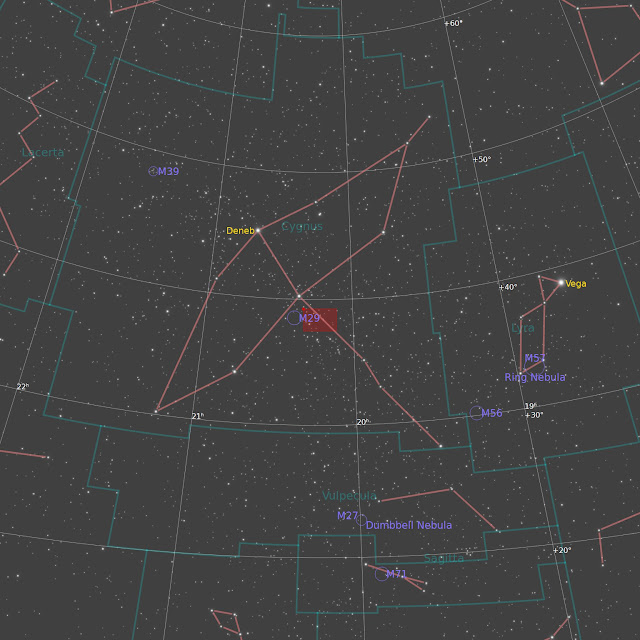Attack of The Floating Space Brain!!!
Tuesday October 3rd was forecast to be our last clear night for about 2 weeks. Even though it was a work night, decided I had to get out and image something. Fortunately, the Sun is setting earlier, which means we can get some time on targets before it gets too late. Unfortunately, the 82% illuminated Moon would rise around 9 PM. Therefore, I decided to image a bright narrowband target using my L-eXtreme Dual Narrowband filter. The target selected was NGC 6888, The Crescent Nebula. I see a floating space brain. Perhaps I've watched too much sci-fi.
 |
| NG6888 - The Crescent Nebula captured on 10/3/2023. Can you spot the Soap Bubble Nebula? |
As soon as I got home from work, I set up the telescope. Once it was dark enough, the scope was polar aligned and PHD2 was calibrated. The sequence, created ahead of time, was initiated and the first sub was taken at 8:19 PM. Tuesday night also happened to be the night our astronomy club's (Buffalo Astronomical Association) imaging group was in session. We are called the Tuesday Night imagers (even though we don't always meet on Tuesday). I was imaging from my backyard, so I joined the group at the observatory via Zoom. One of our members advised that I don't need to calibrate PHD2 every time I setup once I have a good calibration. will have to give this a try next time. Will save a little time setting up. May only need to redo calibration if my setup changes.
I imaged until just a few minutes past midnight, as I would be losing the target to the trees. The Sequence was timed nearly perfectly, the last sub showed a small shadow from the tree. I was already asleep, NINA parked my mount and warmed up the camera. I got up early to retrieve my laptop and put my telescope in the shed. A total of 65 subs were captured at 180 seconds each (Gain 100 / Offset 50).
Processing:
All pre and post processing was performed in PixInsight. Images were reviewed with Blink and the Subframe Selector Process, with a total of 10 images rejected. The 55 remaining subs were loaded in WBPP. Astrometric solution, Autocrop, & 2X Drizzle integration were enabled. Linear: The background was removed with ABE and color calibration was performed with SPCC. The image was deconvolved with BlurXT, noise was reduced with NoiseXT, and the image was stretched with HT.
Non-linear: The stars were removed with StarXT and here's where things get a little interesting. As a result of a conversation on the Zoom, I decided to try the Narrowband Normalization Process (Cosmic Photons) from Bill Blanshan and Mike Cranfield. Specifically, I used the HOO palate (no choice as i was using a dual narrowband filter with an OSC camera) in Blend 2 mode. This process is amazing (as my friend had indicated in our conversation). The Realtime Preview, sliders, and various selections make it easy to get the best results for your image! Stars: Applied saturation with CT, removed green noise with SCNR, and ran the Correct Magenta Stars script. Starless: Applied multiple iterations of CT to add saturation, increase brightness, and contrast. Applied LHE at 3 different kernel sizes. Applied MMT and DSE. I screened the stars back in with Pixel Math and did some star reduction with Bill Blanshan and Mike Cranfield's Star Reduction process. Finally, the image was down samples to a more manageable size.
What is it?
The Crescent Nebula (NGC 6888) is an emission nebula located in the constellation Cygnus. This object is formed by the strong stelar wind from a Wolf-Rayet star (WR 136). This star is losing its outer layers at the rate of the mass of our Sun every 10,000 years. This massive star is likely to go Supernova some day in a million or so years.
 |
| Annotated image of NGC 6888. |
How big is it?
This object has an angular distance of 20 x 10 arcminutes (1 degree is 60 arcminutes) on the night sky. The object is 25 light-years (ly) across.
How far is it?
It is located about 4,700 light-years (ly) from Earth in the Constellation Cygnus.
How to find it?
This object is relatively easy to find. It's very close to the bright star Sadr in the constellation Cygnus. Refer to the finder chart below.
 |
| Finder Chart |



